Level up your baking game! Learn how to use a kitchen scale to precisely measure all your ingredients for foolproof results every time! Step-by-step instructions plus a simple video included!

The Easiest Way to Improve Your Baked Goods
Somehow we’re already right in the midst of baking season. If you’re looking to up your baking game this year and make perfect cakes, cookies, and pies every time, one of the best suggestions I can give you is to start using a kitchen scale.
I’ve mentioned this before in my post on how to measure flour, but this was the biggest game-changer for me in my own kitchen (not to mention it’s critical when you’re developing your own recipes like I do).
However, if you live in the US (like I do), chances are you’re using measuring cups (and you may not even own a kitchen scale!). My goal is to change that. Every baker should use a scale whenever possible.
Tip: This is the kitchen scale that I use (affiliate).
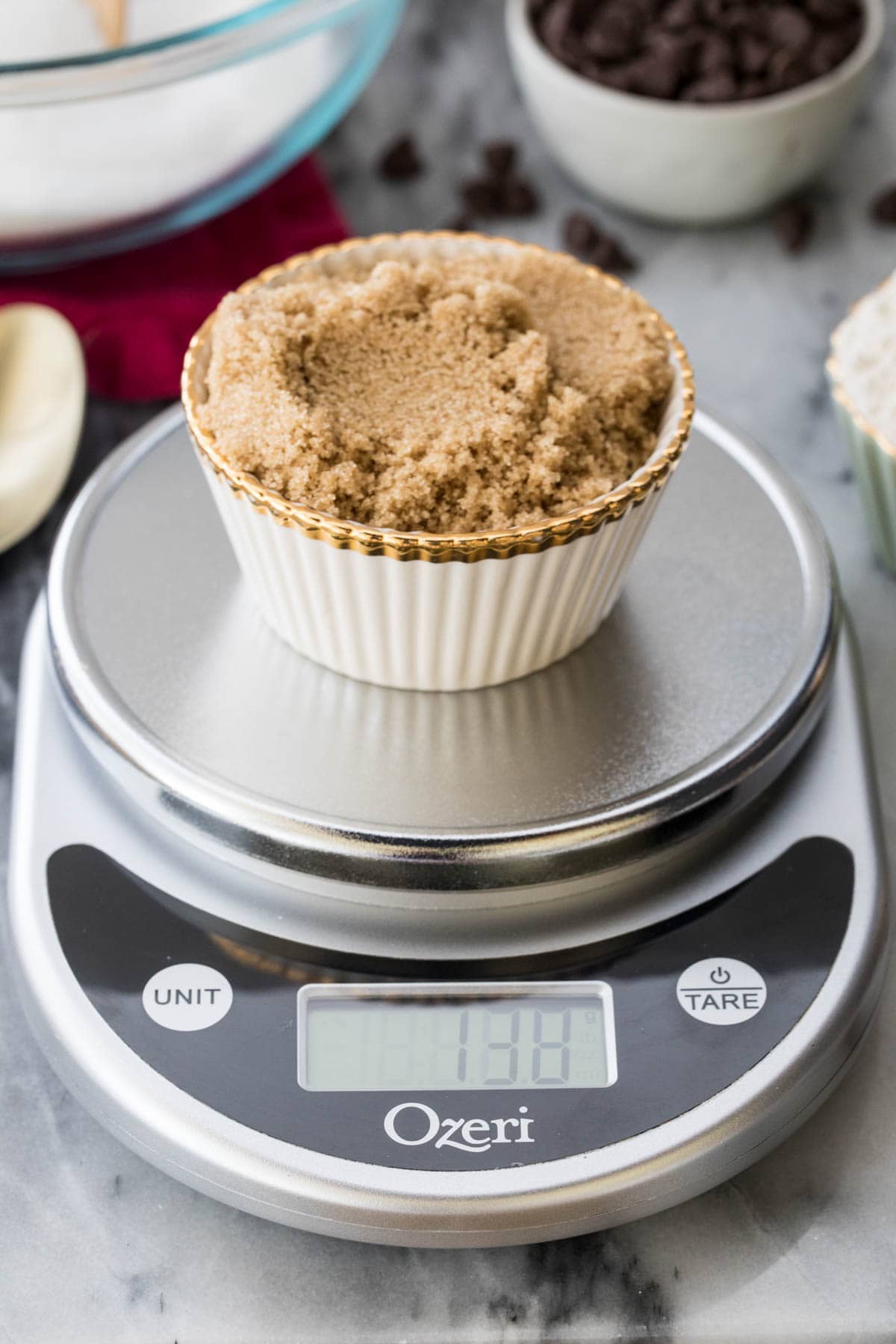
Why Should I Use a Kitchen Scale?
Have you ever experienced:
- Dry, crumbly cookie dough?
- Dense or sunken cakes?
- Frosting that was much, much too sweet and stiff?
- Cakey cookies that don’t spread at all but stay in dough-balls in the oven?
- Cookies that spread paper-thin in the oven?
- Cakey brownies or blondies (rather than fudgy and dense, as they should be?)
These are just a handful of issues that bakers commonly encounter as a result of not measuring their ingredients precisely.
Using a scale takes the guesswork out of the baking process. It also eliminates the need for measuring cups (fewer dishes, yay!).
I love this country, but Americans are way behind on this as most of us don’t even own a kitchen scale. We all use measuring cups, but unfortunately a cup of flour or sugar measured in one baker’s kitchen is rarely precisely the same as a cup measured in another kitchen.
I’m not someone who loves change, so I get that it can seem a little intimidating to make the switch, but ever since I did (thanks to the persuasion of a German friend!) I can’t believe I didn’t make the switch sooner. Using a scale is not difficult, it reduces dishes, and it makes your desserts more likely to turn out perfectly. I can’t stress this enough: once you switch to using a scale, you’ll never want to go back. In fact, you’ll be annoyed when you encounter a recipe that doesn’t include weights.
OK, I get it! Now how do I Use a Kitchen Scale?
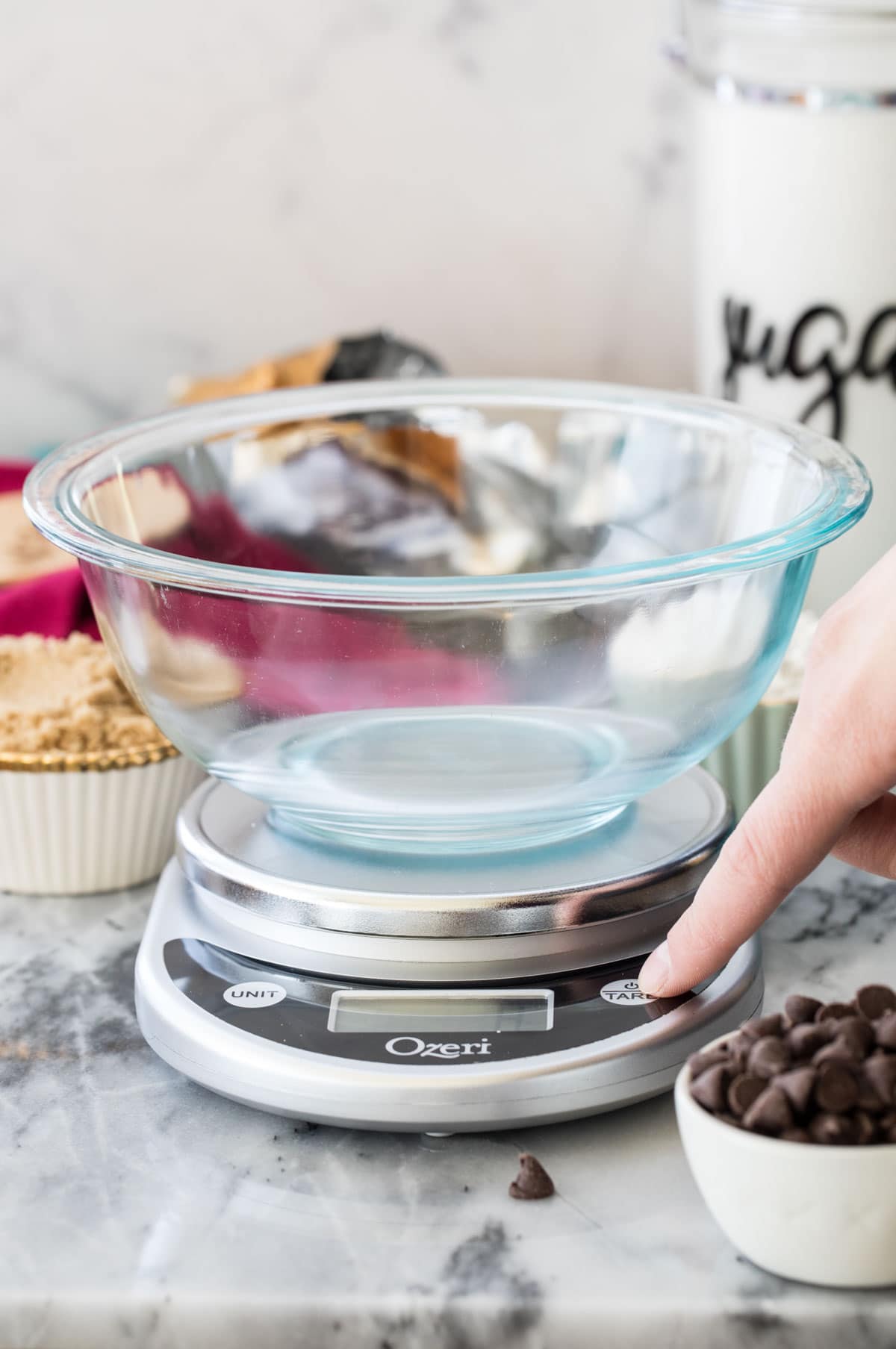
Alright, let’s get to it:
- Turn your kitchen scale ON and toggle the “unit” button until you are set to the unit of measure that you need (oz, grams, etc.)
- Place your mixing bowl (or other bowl that you’ll be measuring your ingredient into) on the scale.
- TARE the scale by hitting the “tare”. Your display should read “0”.
- Measure your dry ingredient into the measuring bowl until you reach the measurement indicated in your recipe.
- Make sure to tare the scale again so that it reads “0” each time before measuring your next ingredient.
I linked to my favorite scale (affiliate) in the how-to card below. It’s accurate, the batteries last forever (mine have been working for years), and inexpensive! I think this one is around $12 on Amazon… comparable to the cost of a set of measuring cups!
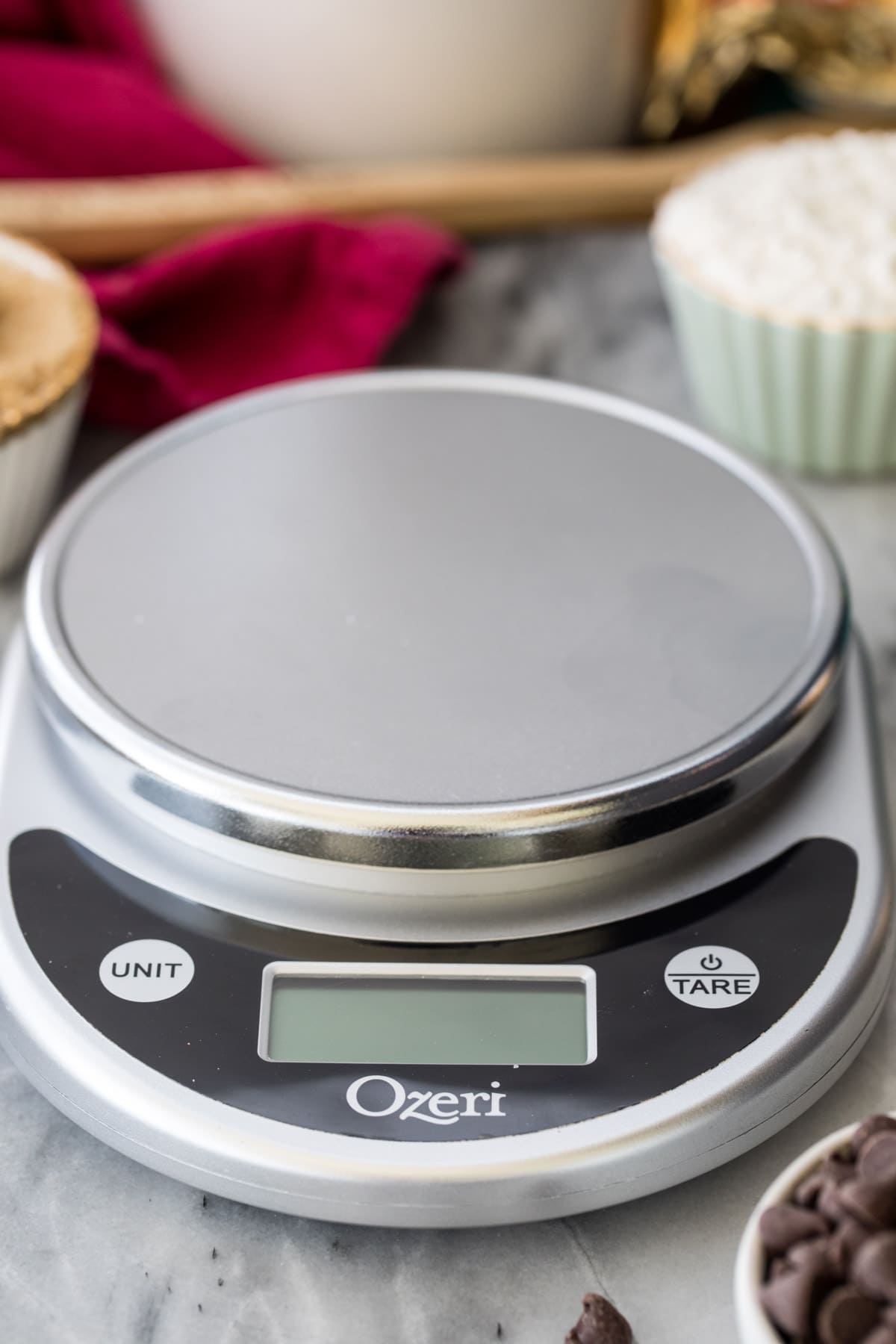
Baking Standards on Sugar Spun Run
For the past several years I have been testing and writing all of my recipes using weights, so wherever you see a weight measurement you can trust that it is precise and exactly what I’ve used in my own kitchen. I have standardized the measurements across my blog. These are the standards that I use for common ingredients:
- 1 cup of all-purpose flour or bread flour = 125 grams
- 1 cup of cake flour = 113 grams
- 1 cup of granulated sugar or brown sugar = 200 grams
- 1 cup of powdered sugar = 125 grams
- 1 cup of cocoa powder = 100 grams
- 1 cup of butter = 226 grams (this standard isn’t so much my own as it is the standard used by butter companies everywhere)
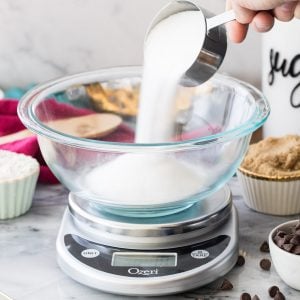
How to Use a Kitchen Scale
Ingredients
- 1 Kitchen scale
Recommended Equipment
Instructions
- Turn kitchen scale on and toggle to the unit of measure that you intend to use (grams, oz, etc.).
- Place a mixing bowl on the scale and hit the tare button so that the display reads "0".
- Weigh your ingredient into the mixing bowl. Tare the scale each time before measuring your next ingredient.
Nutritional information is based on third-party calculations and should be considered an estimate only. Actual nutritional content will vary based upon brands used, measuring methods, cooking method, portion sizes, and more.

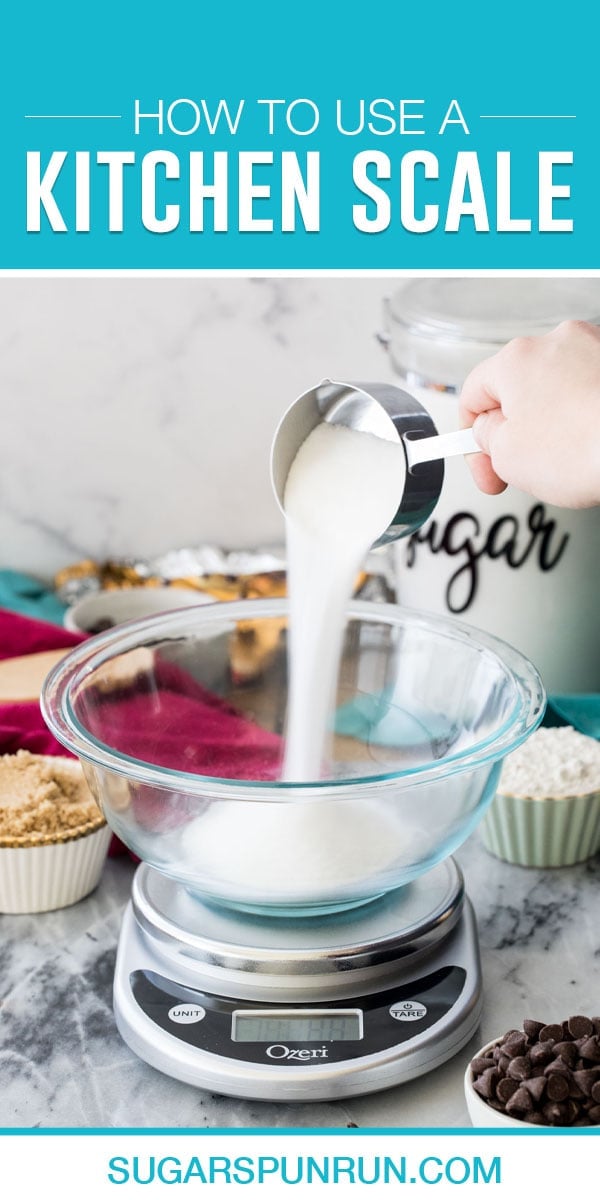
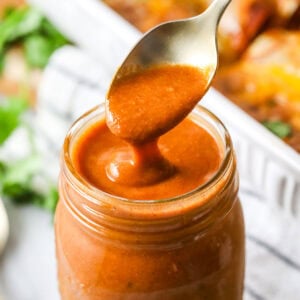
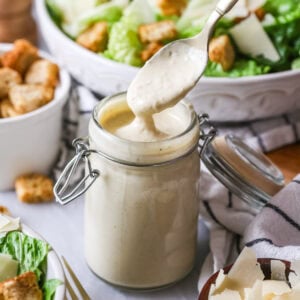
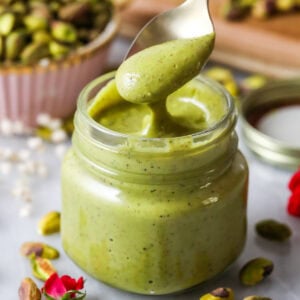
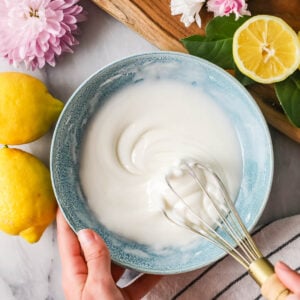
Tristan Schreiner
Hi! Which cake flour is your favorite?! Thanks!
Sam
Hi Tristan! I use either Swan’s down or Pillsbury as they are what is available in my area. 🙂
Rebecca
I just tried your oatmeal cookie recipe (they are yummy!!) – the first recipe of yours I’ve tried. I read the part about using a scale, and even though I DO measure dry ingredients properly, I decided to find the kitchen scale I purchased over 5 years ago (!!!!) but had never used. WOW!!!! It was so easy and I will not go back to measuring cups. I honestly have no idea why I hadn’t tried it before, other than not embracing change too readily (something I’m working on). THANK YOU!!! I’ll certainly be trying more of your recipes.
Sam
Hi Rebecca! Using a scale is definitely a game changer! I’m so glad it was helpful for you. I hope you’ll try some more recipes. I look forward to hearing from you in the future. 🙂
SHARON HURDLE
Hi Sam,
I was wondering if the scale can be
used to measure liquid as well as the dry ingredients.
Sam
Hi Sharon! The kitchen scale I use is calibrated to water so you could technically weigh water on it, but I don’t really recommend it. It’s better to use a liquid measuring cup. 🙂
Cynthia
Hi Sam
What about things like sour cream, cream cheese, and liquid ingredients?
Sam
Hi Cynthia! It depends on how the measurement is given in the recipe. With cream cheese or sour cream or peanut butter I usually list the amount needed by weight, so you would measure it just as described here. For other liquid ingredients such as oil, water, or cream, the amount needed is usually listed by volume (cups, fl oz, or mls) and so it’s best to measure them that way, by volume. If the liquid ingredient is given in oz (not fl oz) or grams, you can use the scale and weigh the same way.
Otherwise, use a measuring cup because a scale, even one with the option for mls or fl oz, generally assumes you are simply measuring water. Other liquids may have a different density than water, so you would not get an accurate measurement using the scale.
Does that help?
Carol Bell
Are all of your standards for basic ingredients listed in another one of your great blog s? I would love to be able to print it out for my older recipes. Your have converted me and I am off to buy a kitchen scale.
Thank you,
Carol
Sam
The kitchen scale is definitely the way to go! I am working on getting a printable conversion sheet made up. I hope to have it ready soon. 🙂
Mikaru86
I’m glad that I was able to convince you to finally enter the modern age of technology XD
On the other hand, if you had used weights from the beginning, I never would have needed to contact you about conversions and substitution after seeing one of your recipes on imgur and wouldn’t have discovered your blog and its plethora of delicious recipes that I’ve enjoyed through the years. So thanks to measuring cups as well I guess 🙂
Sam
Haha! Well I really do appreciate all the encouragement over the years, both for using weights and for making more yeast recipes (I’m working on tackling focaccia now, though don’t expect it til Summer 2021). 😁
Mikaru86
If you are looking for some inspiration, I posted a focaccia recipe as part of my first ever recipe post, almost 5 years ago (after I was inspired by your imgur posts and got back into baking again): https://imgur.com/gallery/cETv9
It’s the second one down, right below the apple pie (which was also based on you sour cream pie crust variant). It’s super easy, just takes some time for the rise periods. I’ve literally never had it go wrong 🙂
Sam
Definitely checking that out (again), thank you! 🙂
Taina Romstadt
How do I know all the measures for other dry ingredients and additives (i.e. dark brown sugar, light, caramel bits, pretzel pieces, other)?
Do you measure dry spices with a scale as well instead of using measuring spoons?
Sam
Hi Tania! The recipe you are using should indicate the weights needed. I just wanted to share a few of my standards that I have. For the spices I do just use measuring spoons. 🙂
Renee
Since I began using/following your recipes, I purchased a kitchen scale.
I saw and tasted the difference immediately.
Now I’m trying to convert my “old” recipes using the weight measure.
Sam
That is so awesome, Renee! It’s definitely much easier to bake with weights. 🙂